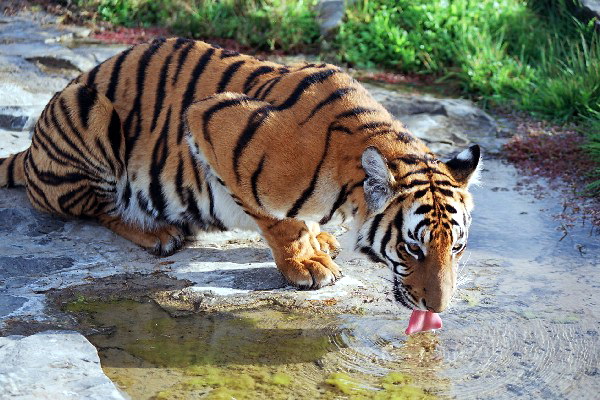South China Tiger (Panthera tigris amoyensis) - Wiki South China Tiger
From Wikipedia, the free encyclopedia
[Photo] South China Tiger 華南虎 Amoy tiger, Panthera tigris amoyensis. From the Shanghai gallery at World66 http://www.world66.com/asia/northeastasia/china/shanghai/lib/gallery
The South China Tiger or South Chinese Tiger (Chinese:華南虎, Panthera tigris amoyensis), also known as the Chinese, Amoy, or Xiamen tiger, is a subspecies of tiger native to the forests of Southern China. The South China tiger is the second smallest and most critically endangered of the living tiger subspecies. Experts maintain that there are approximately 20-30 of these tigers left in the wild. Experts warn that the South China Tiger might become extinct within the next decade. Captive South China tigers can only be found in Zoos in China, no where else on the planet. The South China tiger is considered to be the “stem” tiger, the subspecies from which all other tigers evolved. .
Physical characteristics
The South China tiger is one of the smallest tiger subspecies. Male tigers measure about 2.5 m (8 ft) from head to tail and weigh about 150 kg (330 lb). Female tigers are smaller, measuring about 2.3 m (7 1/2 ft) long. They weigh approximately 110 kilograms (240 pounds). The short, broad stripes of the South China tiger are spaced far apart compared to those of Bengal and Amur tigers.
Diet
The South China tiger, like all other subspecies of tigers, are pure carnivores. They primarily hunts ungulates.The South China Tiger prefers prey ranging between 30-400 lbs and have been known to eat livestocks like cows and goats in the past when their population was much higher. They are expert hunters and will stalk and follow their prey for hours. South China tigers can reach a top speed of around 35-40mph, faster than most of its prey species. These big cats kill their prey with a bite to the back of their neck(usually for medium-sized prey) or use the suffocation hold on the prey's throat(This is their preferred method of killing large-sized prey). South China Tigers can feed on almost anything, from small insects to buffalos, but they are not known to be man-eaters, perhaps because of their limited population.
Habitat
The South China tiger, Panthera tigris amoyensis, was formerly abundant in South China's temperate upland forests. Today its wide range has been reduced to three isolated areas in south-central China, wherein small and scattered populations are said to persist along the mountainous borders between provinces. As with the black-footed ferret, one of the biggest contributing factors to the South China tigers' dwindling population is the destruction of its prey base. Two other major factors that have contributed to the tiger’s decline are poaching and population fragmentation. South China Tigers , like other tiger subspecies, live in dense jungles. South China tigers also love spending time in water, similar to other tiger subspecies.
Conservation
Since 1990, China’s State Forestry Administration has been leading the effort to save the South China Tiger through the establishment of special Nature Reserves for the 10-30 Chinese tigers thought to be left in the wild. China's few captive tigers are now part of a centrally registered studbook in an attempt to save this tiger from becoming the fourth tiger subspecies to become extinct in modern times. Before a studbook was established it was thought that this captive population was too small and lacking in genetic diversity for any re-population program to be successful, but since the start of the central register more and more South China Tigers have been identified in zoos across China fueling hope of the possible re-establishment of the South China Tiger in the wild.
The organisation Save China's Tigers working with the Wildlife Research Centre of the State Forestry Administration of China and the Chinese Tigers South Africa Trust secured an agreement on the reintroduction of Chinese Tigers into the wild. The agreement, which was signed in Beijing on 26 November 2002, calls for the establishment of a Chinese Tiger Conservation model through the creation of a Pilot Reserve in China where indigenous wildlife including the South China Tiger will be reintroduced. A number of Chinese tiger cubs will be selected from zoo's in China and sent to a 300 square kilometre reserve near the town of Philippolis in South Africa where they will be taught to hunt for themselves. A second Chinese tiger rehabilitation project is also being run in Fujian, China. It is planned that in time, successfully rehabilitated South China Tigers will be released into a Pilot Reserve in China. China will conduct the work of surveying land, restoring habitat and prey with in the Pilot reserve. The first Chinese Tigers are expected to be reintroduced into the wild to coincide with the Beijing Olympic Games in 2008.
Some Experts, however, disagree with the Save China's Tiger project as they feel that the tigers released should not mate with any wild south china tigers as these released tigers are suffering from inbreeding. If a wild South China tiger was to mate with a released South China Tiger, their cubs will also suffer from inbreeding and might affect the whole South China tiger population negatively.
http://en.wikipedia.org/wiki/South_China_Tiger
| The text in this page is based on the copyrighted Wikipedia article shown in above URL. It is used under the GNU Free Documentation License. You may redistribute it, verbatim or modified, providing that you comply with the terms of the GFDL. |
